By
2014
Thursday, June 19, 2014 – 2:00 pm-4:00 p.m. EDT
Key Findings from NAWM's National Report on State Definitions, Jurisdiction and Mitigation Requirements in State Programs for Ephemeral, Intermittent and Perennial Streams in the United States – Brenda Zollitsch, PhD, Policy Analyst, NAWM
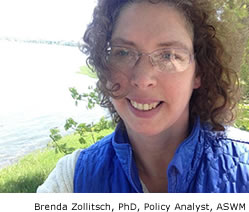 This NAWM Member’s Webinar presented key findings from our two-year project to document the status of and trends in stream identification, delineation and mitigation practices for ephemeral, intermittent and perennial streams across the United States. The webinar presented highlights from the study’s comparative analysis, which was based on in-depth interviews with state staff from 47 states. The webinar presented findings on how stream impacts are integrated into state dredge and fill and 401 certification programs, information about stream identification and assessment methods, and practices for mitigating stream alteration and degradation. The study finds substantial variability in the terms and methods used by states and provides a valuable snapshot of practices and where they are trending at this time of rapid growth in mitigation programs and practices. This project was funded by a U.S. EPA Wetland Program Grant and the McKnight Foundation.
This NAWM Member’s Webinar presented key findings from our two-year project to document the status of and trends in stream identification, delineation and mitigation practices for ephemeral, intermittent and perennial streams across the United States. The webinar presented highlights from the study’s comparative analysis, which was based on in-depth interviews with state staff from 47 states. The webinar presented findings on how stream impacts are integrated into state dredge and fill and 401 certification programs, information about stream identification and assessment methods, and practices for mitigating stream alteration and degradation. The study finds substantial variability in the terms and methods used by states and provides a valuable snapshot of practices and where they are trending at this time of rapid growth in mitigation programs and practices. This project was funded by a U.S. EPA Wetland Program Grant and the McKnight Foundation.
| Part 1: Introduction: Marla Stelk, NAWM Presenter: Brenda Zollitsch, PhD, Policy Analyst, NAWM |
Part 2: Brenda Zollitsch, PhD, Policy Analyst, NAWM |
Part 3: Brenda Zollitsch, PhD, Policy Analyst, NAWM |
||
| Part 4: Brenda Zollitsch, PhD, Policy Analyst, NAWM |
Part 5: Questions/ Discussion |
|||
Thursday, May 22, 2014 – 2:00 p.m. Eastern, 1:00 Central, 12:00 Mountain, and 11:00 Pacific
Introduction – Jeanne Christie, NAWM
Special Topic – Mitigating for Ditches and Altered/Modified Streams
Webinar Description: This webinar will build on findings on the mitigation of ditches and altered/modified streams from NAWM’s recent research on state stream identification, delineation and mitigation across the United States. To address this timely and complex issue, we have pulled together a panel to share with you and discuss some of the different approaches to mitigating impacts to ditches and altered/modified streams. We will begin with a brief summary of findings on mitigation for ditches and modified/altered streams from the recent NAWM Stream Report. Next, we will hear panel presentations on mitigation requirements, what counts as mitigation and how debits/credits are assigned for ditches/modified streams in New Jersey, Virginia and Tennessee. Finally, we will provide an opportunity for Q&A with panelists and about findings on ditches and modified/altered streams in the NAWM Stream Report.
Webinar Panelists:
Susan Lockwood & Vincent Mazzei – New Jersey Department of Environmental Protection
Bettina Sullivan – Virginia Department of Environmental Quality
Vena Jones – Tennessee Department of Environment and Conservation
| Part 1: Introduction, Jeanne Christie and Brenda Zollitsch, NAWM |
Part 2: Susan Lockwood and Vincent Mazzei, New Jersey Department of Environmental Protection |
|||||||||||
| Part 3: Bettina Sullivan, Virginia Department of Environmental Quality |
Part 4: Vena Jones, Tennessee Department of Environment and Conservation |
Thursday, April 17, 2014 – 2:00 p.m. EST
Introduction – Jeanne Christie, NAWM [View Webinar]
Special Topics: Mitigating For Impoundments
Presentation of research on the impacts of impoundments on water quality
Followed by panel presentations by:
- Robby Baker, Tennessee Department of Environment and Conservation
- David Goerman, Pennsylvania Department of Environmental Protection
- Stacia Bax, Missouri Department of Natural Resources
- Rusty Wenerick, South Carolina Department of Health and Environmental Control
| Part I: Introduction, Jeanne Christie, NAWM |
Part 2: Robby Baker, Tennessee DEC |
Part 3: David Goerman, PA DEP |
|||
| Part 4: Stacia Bax, MO DNR |
Part 5: Rusty Wenerick, SC DHEC |
Part 6: Questions & Answers |
|||
Thursday, February 20, 2014 – 2:00 p.m. EST
Assessment Methodology
March 4-6, 2014
NAWM Annual Meeting
Thursday January 16, 2014 – 2:30 p.m. EST
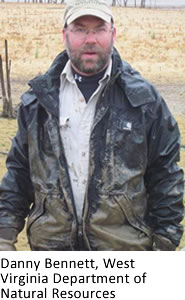
Introduction – Jeanne Christie, NAWM
Learning to "SWVM" (Stream and Wetland Valuation Metric) – Danny Bennett, West Virginia Department of Natural Resources
Through the national stream identification, delineation and mitigation project, we have identified a wide range of tools and techniques that may be of interest to other states. There are a number of different mitigation, assessment and evaluation tools that have been identified through this process. One tool that has integrated many different elements from other tools has been the West Virginia Stream and Wetland Valuation Metric.
Our January 16th webinar Danny Bennett, of the West Virginia Department of Natural Resources gave a presentation on the history behind creation of the West Virginia Stream and Wetland Valuation Metric, its components and some lessons learned.
Danny Bennett was born and raised in Richmond, Virginia but his family has a long history in West Virginia with roots in the Beckley and Shinnston areas. After marrying Tina, they packed up and relocated to Knoxville, Tennessee where he attended the University of Tennessee earning his Masters of Science degree working with black bass on Norris Reservoir. After graduation, he worked as a contractor for the Tennessee Valley Authority conducting IBI surveys in the Clinch/Powell watersheds. He accepted the position of Coordination Biologist with the West Virginia Division of Natural Resources in 1998. While at WVDNR he has received training in wetland delineation and completed the Rosgen Natural Stream Design courses (I-IV). His responsibilities include coordinating agency responses to 404/401 permits, commenting on NEPA documentation for projects throughout the state, representing the agency at a variety of meetings/workshops, and he serves on the Interagency Review Team. He has three very active children. He coaches his twelve year old son’s baseball team, is an Assistant Scout Master, helps with various church activities, travels with his ten year old daughter to highland dance competitions, is involved in 4-H with his fifteen year old daughter and in his “spare time” enjoys waterfowl hunting with a very stubborn Chesapeake Bay retriever.
2013 [2012]
Thursday, December 19, 2013 – 2:00 p.m. EST
Update and Advice on Data Analysis
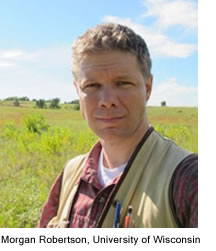 Thursday, July 25 – 2:00 p.m. EST
Thursday, July 25 – 2:00 p.m. EST
Introduction – Jeanne Christie, NAWM [View Webinar]
Science Policy and Outcomes in Developing Stream Compensatory Mitigation Criteria – Morgan Robertson University of Wisconsin, Rebecca Lave, Indiana University and Martin Doyle, Duke University
Our talk highlighted preliminary results of our multidisciplinary NSF-funded research on the policy development and hydrogeomorphic outcomes of compensatory stream mitigation criteria in three different states: Oregon, Ohio and North Carolina. The presentation was in two parts, with the first focusing on the themes and consistent topics of debate that characterize the creation and adoption of compensatory stream mitigation criteria across our research sites. In the second part, we discussed our preliminary findings on the geomorphological comparison of stream compensation restoration sites with non-restored sites in North Carolina.
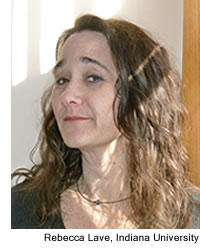 Morgan Robertson is an Assistant Professor of Geography at the University of Wisconsin-Madison. He received his Ph.D. from the University of Wisconsin-Madison in 2004, and conducted postdoctoral research at the US Environmental Protection Agency developing regulations governing wetland credit markets. He taught and conducted research at the University of Kentucky from 2007 to 2012. His research focuses on the interface of science and economics in ecosystem service markets.
Morgan Robertson is an Assistant Professor of Geography at the University of Wisconsin-Madison. He received his Ph.D. from the University of Wisconsin-Madison in 2004, and conducted postdoctoral research at the US Environmental Protection Agency developing regulations governing wetland credit markets. He taught and conducted research at the University of Kentucky from 2007 to 2012. His research focuses on the interface of science and economics in ecosystem service markets.
Rebecca Lave is an Assistant Professor and Director of Undergraduate Studies in the Department of Geography at Indiana University. She has published in journals including Science, Social Studies of Science, Ecological Restoration, and the Journal of the American Water Resources Association. Her new book “Fields and Streams: Stream Restoration, Neoliberalism, and the Future of Environmental Science (U. Georgia Press 2012)” analyzes the fight over Dave Rosgen’s Natural Channel Design approach.
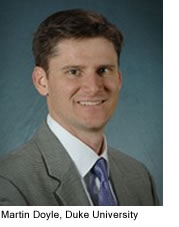
Martin Doyle is Professor of River Science and Policy, with training in hydrology, geomorphology, and engineering. His research is at the interface of science, economics and policy of environmental management and restoration. His background is in hydraulics and sediment transport in rivers, but he also works on river infrastructure, including decommissioning dams and levees, as well as research on financing rehabilitation of aging hydropower dams and the impacts of infrastructure on river ecosystems across the US. He holds a PhD in Earth Science from Purdue University, and a Masters in Environmental Engineering from Ole Miss. His research has resulted in several awards including a Guggenheim Fellowship (2009), a National Science Foundation Early Career Award (2005), the Nystrom Award from the Association of American Geographers (2004), the Horton Grant from the American Geophysical Union (2001), and the Chorafas Prize from the Chorafas Foundation in Switzerland (2002). For his work in bridging environmental science and policy, in 2009 was named the inaugural Frederick J Clarke Scholar by the US Army Corps of Engineers. In 2008 Dr Doyle was named an Aldo Leopold Leadership Fellow by Stanford University, and received a GlaxoSmithKline Faculty Fellowship for Public Policy from the Institute for Emerging Issues. More information on research program, click here.
| Part 1: Introduction, Jeanne Christie, NAWM |
Part 2 | Part 3 |
Thursday, May 23 – 2:00 p.m. EST – Webinar
Introduction – Jeanne Christie, NAWM
How to Use RIBBITS to Understand and Compare Stream Mitigation Banking and in Lieu Fee Practices Around the Country – Steve Martin, U.S. Army Corps of Engineers
| Part 1: Introduction & Steve Martin, USACE |
Part 2: Steve Martin, USACE |
||||||
| Part 3: Steve Martin, USACE |
Part 4: Steve Martin, USACE |
Wednesday, March 20 – 1:00-3:45 p.m. EST – Workshop/Webinar
1:00 p.m. - 1:45 p.m. The Ordinary High Water Mark: Concepts, Research, and Applications – Matthew Mersel, U.S. Army Corps Engineer Research and Development Center
1:45 p.m. - 2:45 p.m. Site Selection and Design for Stream Mitigation – Will Harman, Stream Mechanics
| Part 1: Will Harman, Stream Mechanics |
Part 2: Will Harman, Stream Mechanics |
Part 3: Will Harman, Stream Mechanics |
2:45 p.m. - 3:15 p.m. Break
3:15 p.m. - 3:45 p.m. Out of Kind Stream Mitigation – Brian Topping, Wetland Division, U.S. Environmental Protection Agency
Thursday, February 28 – 2:00 p.m. EST
Thursday, January 24 – 2:00 p.m. EST
Topic – Western stream identification and delineation methods
Streamflow Duration Assessment Method for the Pacific Northwest, Tracie Nadeau, U.S. Environmental Protection Agency
The Streamflow Duration Assessment Method for the Pacific Northwest is a scientific tool providing a rapid assessment framework to distinguish between ephemeral, intermittent and perennial streams. It results from empirical design and statistical analysis of field data, and a four year validation study spanning three states (WA, ID, OR) and a diversity of hydrologic landscapes. This presentation will discuss development, validation, and application of the method.
| Part 1 |
A Review of Ordinary High Water Mark Research in the Western U.S. and Future Studies, Matt Mersel, U.S. Army Corps of Engineers
Delineation of the ordinary high water mark (OHWM) on stream channels can be challenging in light of its vague legal definition and the inherently dynamic nature of stream systems. Inconsistent OHWM delineation practices result in part from an unclear understanding of what the OHWM represents scientifically and a lack of research into the spatial and temporal stability of the physical indicators used to identify the OHWM. This presentation will discuss past and ongoing studies conducted by the U.S. Army Corps Engineer Research and Development Center, aimed at exploring OHWM indicator distribution and reliability in several regions of the country including the Arid Southwest and Western Mountains. Additionally, concepts of the OHWM and potential study designs for future studies in the East and nationally will be discussed.
| Part 2 | Part 3 |
2012 [July – September – October – November]
Thursday, July 26 – 2:00 p.m. EST
Thursday, September 27 – 2:00 p.m. EST
Thursday, October 25 – 2:00 p.m. EST
Topic – North Carolina Stream Mitigation Program – Eric Kulz, North Carolina Division of Water Quality and Todd Tugwell, U.S. Army Corps of Engineers, Wilmington District
| Part 1: Intro & History | Part: 2 | |||
| Par:t 3 | Part: 4 |
Thursday, November 15 – 2:00 p.m. EST
Topic – Natural Channel Design
Functions Lost, Functions Gained: Can Stream Mitigation Work? – Will Harman, Stream Mechanics
| i | ||||||
| Part 1 | Part 2 | Part 3 |
[Return to top]
[Future Webinars]
